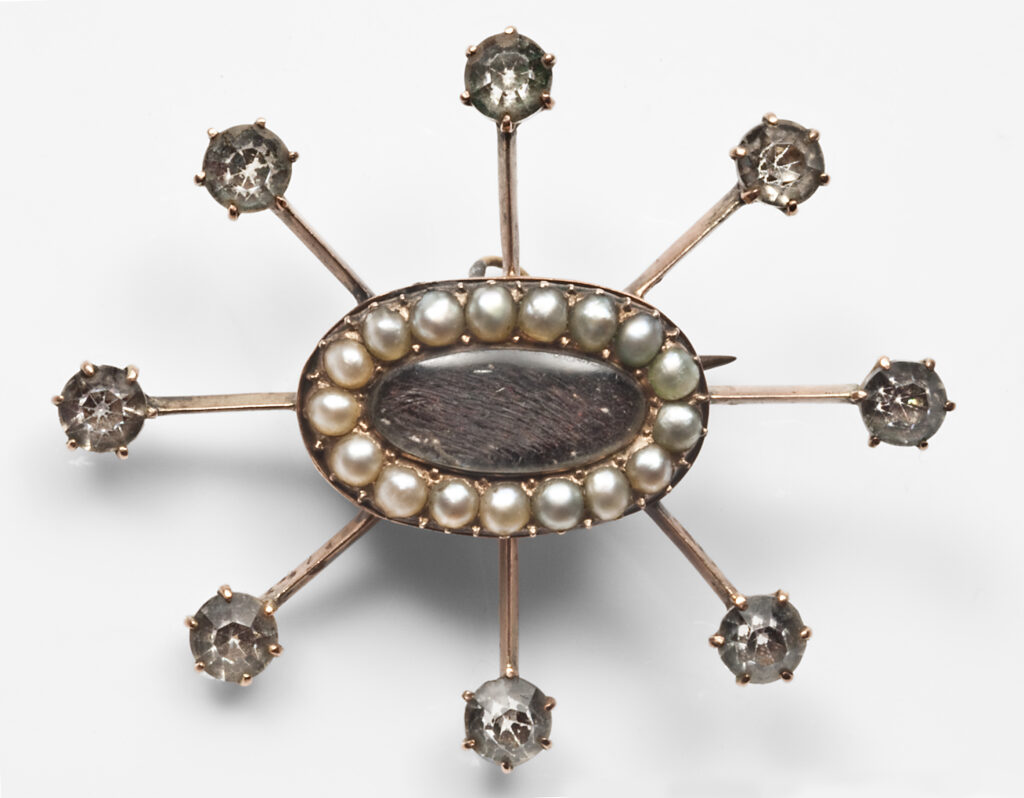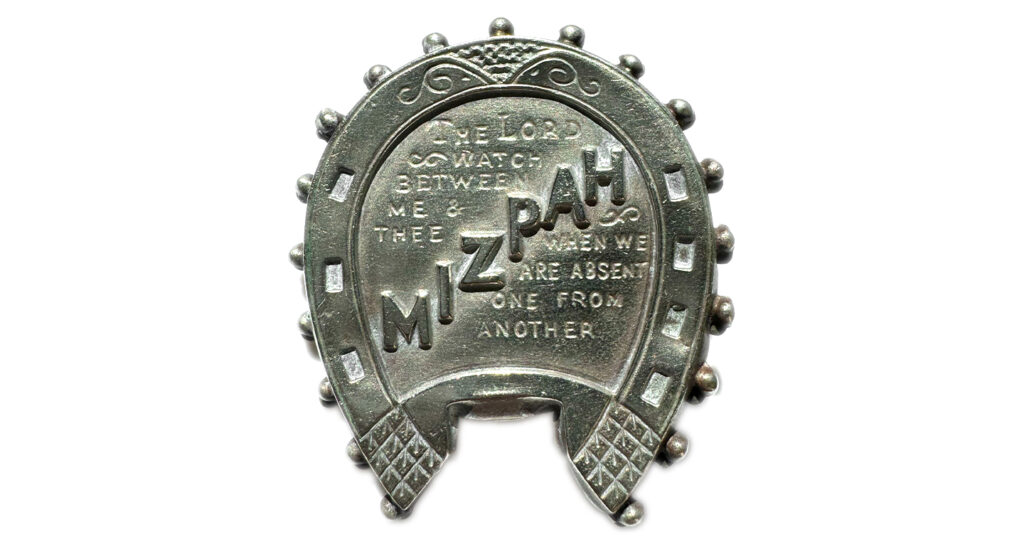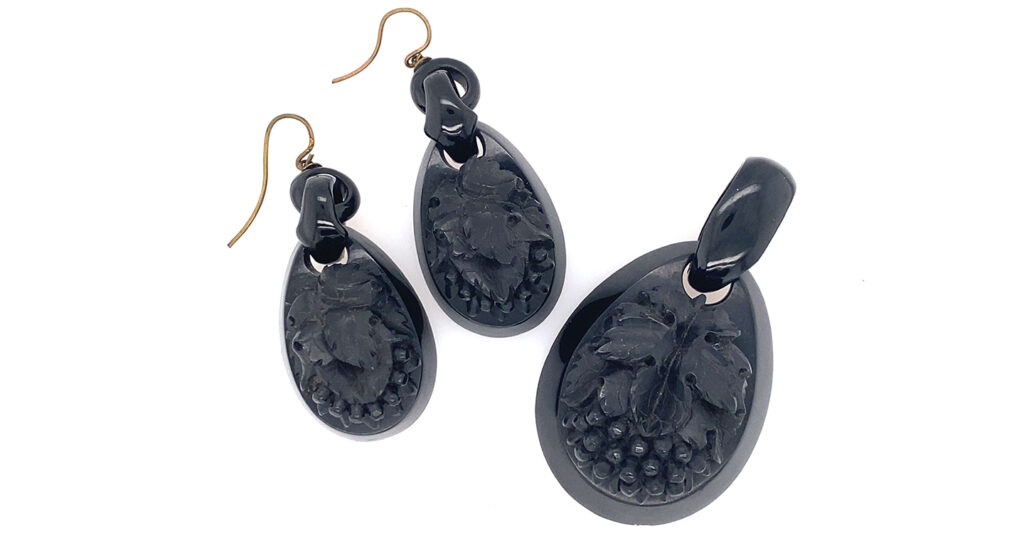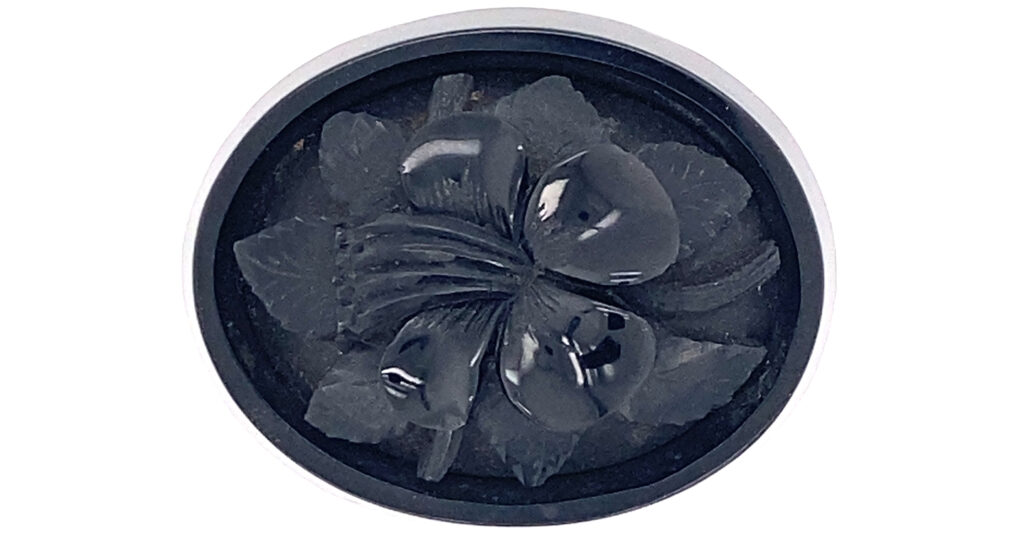Foiled by Paste in a 19th Century Brooch
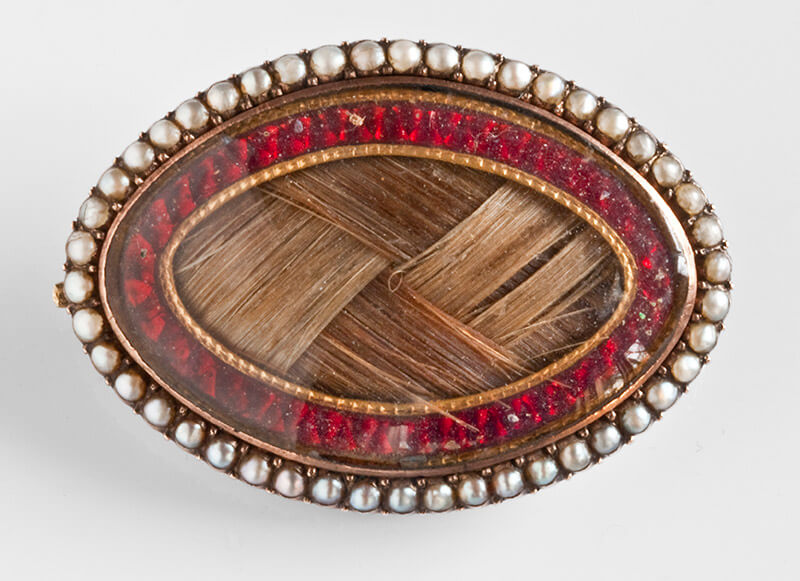
This wonderful brooch consists of yellow gold with foiled amethysts/pastes. There are elements to the brooch which show many influences of the Gothic Revival period in the first half of the 19th century, mainly in the floral embellishments to the gold surround of the hairwork. Inside is a dual-woven hair memento and to the reverse, the pin-clasp and ring for the safety guard.
Change in 19th Century Society
As Queen Victoria bought society back to the Christian values and the concept of the ‘family’ which had previously been pushed aside, much in part due to the Enlightenment, increased industrialisation and the high social-political turmoil since the 16th century.
Much of the 19th century’s change in thought was a reaction to religious non-conformity in an effort to swing back to the ideals of the High Church and Anglo-Catholic self-belief. This was a time when heavy industry was on the rise and modern society (as we consider it today) was established, a time of radical change that challenged pre-existing ideals of society. Though there had been growing small scale social mobility from the late 17th century, the late 18th and early 19th centuries saw the middle classes having the opportunity to promote through society with the accumulation of wealth. Augustus Welby Northmore Pugin, a designer, architect and convert to Catholicism, saw this industrial revolution as a corruption of the ideal medieval society. Through this, he used Gothic architecture as a way to combat classicism and the industrialisation of society, with Gothic architecture reflecting proper Christian values. Ideologically, Neoclassicism was adopted by liberalism; this reflecting the self, the pursuit of knowledge and the freedom of the monotheistic ecclesiastical system that had controlled Western society throughout the medieval period. Consider that Neoclassicism influenced thought during the same period as the American and French revolutions and it isn’t hard to see the parallels. The Gothic Revival would, in effect, push society into the paradigm of monarchy and conservatism, which would dominate heavily throughout the 19th century and establish many of the values that are still imbued within society today.
Hair Dedication
Note the thick hair weave and the fashionable gold work to the rim of the memento. From this, we can see the change in the style of the sentimental jewel and how it was presented. Firstly, the interior oval shape is quite typical of the pre-1830s and the smaller shape brings into focus the hairwork as the primary motif in the jewel, rather than placing a Neoclassical depiction inside.
The smaller oval shape carried on from the early 19th century to c.1840, developing into the larger ovals of the post 1850 period.Many of the larger shapes were there to accommodate larger fashion, with the crinoline becoming popular, larger jewels worn at the wrist and neck were required to balance the voluminous skirts and sleeves. Through this, the 1854 Hallmarking Act led to the allowance for lesser alloys being used for jewels, such as Pinchbeck, used to create lighter, larger jewels. Jet grew in prominence from this period because of similar reasons.
The hairwork is essentially the most important factor in all these jewels. They were made to cement a relationship and the displaying of the hairwork is still within the oval shape that had its roots in the early 19th century.
It is quite necessary that we look to the lack of these allegorical motifs and a return to the sentimental hairwork as a reflection upon the society that wore them. This is a Western society still developing, with heightened industrialisation, colonialism and emerging from the Napoleonic wars, hence, as it was when these jewels became popular during the late 17th century and hairwork was the main sentiment, the hair here is the focus.
From what this brooch brings back to social etiquette is the focus of the hair as a union and a representation of the ‘self’ and not creating an ecclesiastical or allegorical statement around the sentiment of love. It is the combination of two people inside a brooch and worn prominently for public viewing of that message.
Amethysts / The Colour Purple
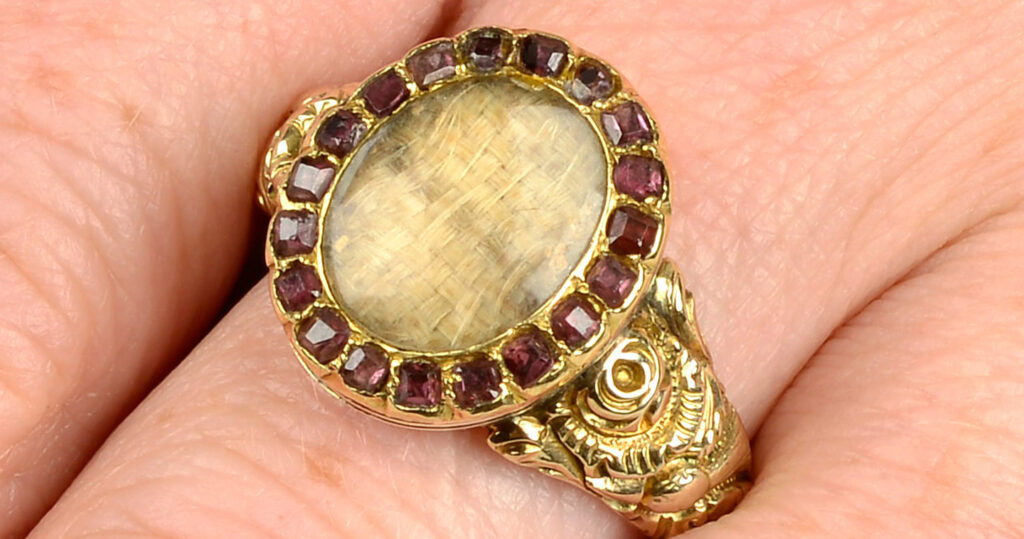
Purple was an important colour for both sentimental and mourning purposes in jewellery of the 19th century, with its underlying meaning of love. This is a factor which became only more prominent as the 19th century wore on with sentimental jewels.
For this brooch, the irregularity in size of the paste, which can be seen clearly upon the reverse, show the brooch was the sum of its parts. The paste wasn’t exact in its creation and the jeweller accommodated the brooch for this.
Associated with the Church, due to the the intrinsic connection through the colour purple (robes), amethysts are used in Bishop’s rings and crosses. The purple colour also allows for a third-stage mourning colour to be used in costume after the 1817 statement on Court Mourning by Lord Chamberlain. The religious connection here cannot be overstated, especially post 1840 and with the instillment of family values by Queen Victoria, following on from the Gothic Revival movement. A perfect amethyst should be deep purple and reflect colours of red when turned in the light.
In the post 1860 culture, violet was bought back into the post-mourning environment. First mourning lasted one year and a day, outdoor garments for this would be shown by the plainness and amount of crape, jet jewellery was permitted. After one year and a day, Second stage was introduced. This involved less crape and its application to bonnets and dresses became more elaborate. It was frowned upon if this period was entered into too quickly and it lasted nine months in all. The Third stage (or Ordinary stage), introduced after twenty-one months, involves the omission of crape, inclusion of black silk trimmed with jet, black ribbon and embroidery or lace were permitted. Post 1860, soft mauves, violet, pansy, lilac, scabious and heliotrope were acceptable in half mourning. This period lasted three months. The English Woman’s Domestic Magazine stated that ‘many widows never put on their colours again’ and this was quite a statement for the identity of the woman, which was held under the veil of mourning and family symbolism for the rest of her life. Hats, shawls, mantles, gloves, shoes, fans all changed during mid century, and pagoda sleeves from 1850-70 were fashionable, designed to be stitched to the outer sleeve to cover modesty from the lower arm and wrist. Wide skirts from the 1850s-70s, tie back fashions of the late 1870s and the ‘S-bend’ look of the early 1900s all were adapted to mourning fashion, without a clear definition of difference between them.
What this represents is that a colour used for love and piety could be bought back into the lexicon of fashion and love after a period of mourning, where it had been worn before mourning. While it was not necessarily something that social proprietary allowed to be bought back into daily fashion, the opportunity was there, as it was a colour designed for love.
The Floral Arrangement
One of the most prominent motifs bought back to life by the Gothic Revival was the Baroque floral embellishments. As Baroque style was designed to instil a sense of grandeur above human society to impose religious glory and piety, the designs were intrinsic into carrying on the message of Anglo-Christian ideals that the Gothic Revival needed to flourish. The adapted acanthus designs, along with rose and other floral decorations harken back to the early 16th century onwards, before the 17th century Rococo movement made the patterns more organic and uncomplicated.
This is a motif that permeated many of the mainstream jewels post 1810. While the period of 1810-20 was a popular one for the oval shapes and the discovery of new styles before standardisation, the Gothic Revival jewels were the pieces that succeeded along with the change in society. Gone were the excesses of the previous generation and the push towards the ‘self’, now were the values of the family and the dominance of a matriarch under an English supreme governor, a theme that would carry through to the end of the 19th century and bring about the downfall of the mourning industry.
The adaptation of the floral style was not only just a reaction to the Gothic Revival, but one that resonated with the language of flora and fauna. The Illustrated Language of Flowers by Anna Christian Burke categorised over seven hundred elements of flora and fauna, which gave the Victorians a resonance of design elements to represent their emotions in jewellery and ephemera designs for gifts towards others. Even more symbols were built upon this, increased only by the discovery of challenging thought in a time where science and religion were becoming equals, to make the smallest element of design important to represent a relationship in society.
Wearing
To be worn at the neck, this brooch takes into account all of the above sentiments and presents them in a public forum. When eye-contact is made with the wearer, this particular brooch would have been seen to denote the status of that person.
As a token of love for the purposes of giving, this piece suggests that the union of the two was already cemented, as the social proprietaries of giving a jewel for the token of love suggest the promise of a future relationship and having that known amongst family, beyond the token of appreciation. This jewel has the hair entwined, which was often reserved for families or those within an ordained union, hence when a loved one is apart from the other, the hair is always close to them.
Taking this back to the hair being seen by others around them, the individual woman has her affection worn and announced herself as being held in a loving union, which would deflect advances that may deem inappropriate within society.




